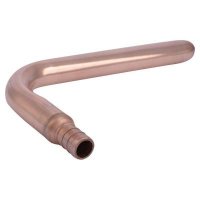I’m a plumbing novice learning all of what I currently know in the last year after purchasing a new (older) home. My only experiences being some drain unclogging with an auger, relocation of a hose bib using PEX, and some leak repairs. I’m going to embark on a whole house re-pipe after discovering the costs are outside of what I’d like to pay. I feel confident in my intelligence and ability to do this.
I would like to take you through the setting, my current plan/thoughts, and then end with some questions. Anyone who so kindly takes the time to read and reply (if you so choose) would gain my sincerest appreciation. If you do choose to reply please be as thorough as you can and keep the lingo to a minimum please so as not to confuse the ignorant ones (me!).
Setting: 1959 one-story ranch-style house, full basement (mostly finished); galvanized steel supply lines throughout; point of entry for supply in utility room; supply is recently installed 1”PEX from street (helped remedy most of our flow problems). The supply currently reduces to ½” once past the house shut-off valve. The reduction is part of the original configuration; old water service was ¾” steel.
Plan: ¾” main from source with ½” branch lines to fixtures. I’m choosing this method because I think it better suits the layout of the house, and I think it would be easier in my case (my own thinking, of course).
Output fixtures: kitchen sink, clothes washer, three hose bibs, utility sink (hot and cold), two bathrooms (each has a toilet, sink, and shower; one bathroom also includes a tub not combined with shower). (Tankless water heater, just to be thorough.)
My questioning might be disjointed but that’s just because I don’t know where to start and if more questions might pop into my head as I’m typing. I plan to also come back to this thread as the project progresses.
--Can I abandon the galvanized pipes in place? Any issues with doing that? I’m going to do my best to remove as much as I can, but who knows what I might come across.
--When I stub out for fixtures and shut-off valves should I come out of the wall with PEX or is a transition to another material preferred? This would be under the kitchen and bathroom sinks, the tub, and the showers.
--I plan to install either a pressure-balancing valve or thermostatic valve for the showers and one manufacturer indicated not to use PEX from the top of the valve to showerhead spout; is this just the manufacturer being safe or is that being code-compliant?
--Do people support PEX to studs/framing for longer vertical or horizontal runs if given the opportunity/space? Would support for PEX be recommended/needed anywhere?
--Would I have grounding concerns? I know I have a grounding rod in the backyard, and also one specific to the solar array (due to code), but not sure if I need to be concerned about something here….
--Any off-hand ideas whether I might be concerned with bringing anything up to code based on the age of the house? Not sure what to specify here, just spitballing for ideas.
Thanks to all for stopping by!
Michael
I would like to take you through the setting, my current plan/thoughts, and then end with some questions. Anyone who so kindly takes the time to read and reply (if you so choose) would gain my sincerest appreciation. If you do choose to reply please be as thorough as you can and keep the lingo to a minimum please so as not to confuse the ignorant ones (me!).
Setting: 1959 one-story ranch-style house, full basement (mostly finished); galvanized steel supply lines throughout; point of entry for supply in utility room; supply is recently installed 1”PEX from street (helped remedy most of our flow problems). The supply currently reduces to ½” once past the house shut-off valve. The reduction is part of the original configuration; old water service was ¾” steel.
Plan: ¾” main from source with ½” branch lines to fixtures. I’m choosing this method because I think it better suits the layout of the house, and I think it would be easier in my case (my own thinking, of course).
Output fixtures: kitchen sink, clothes washer, three hose bibs, utility sink (hot and cold), two bathrooms (each has a toilet, sink, and shower; one bathroom also includes a tub not combined with shower). (Tankless water heater, just to be thorough.)
My questioning might be disjointed but that’s just because I don’t know where to start and if more questions might pop into my head as I’m typing. I plan to also come back to this thread as the project progresses.
--Can I abandon the galvanized pipes in place? Any issues with doing that? I’m going to do my best to remove as much as I can, but who knows what I might come across.
--When I stub out for fixtures and shut-off valves should I come out of the wall with PEX or is a transition to another material preferred? This would be under the kitchen and bathroom sinks, the tub, and the showers.
--I plan to install either a pressure-balancing valve or thermostatic valve for the showers and one manufacturer indicated not to use PEX from the top of the valve to showerhead spout; is this just the manufacturer being safe or is that being code-compliant?
--Do people support PEX to studs/framing for longer vertical or horizontal runs if given the opportunity/space? Would support for PEX be recommended/needed anywhere?
--Would I have grounding concerns? I know I have a grounding rod in the backyard, and also one specific to the solar array (due to code), but not sure if I need to be concerned about something here….
--Any off-hand ideas whether I might be concerned with bringing anything up to code based on the age of the house? Not sure what to specify here, just spitballing for ideas.
Thanks to all for stopping by!
Michael


